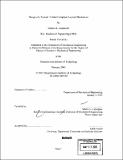| dc.contributor.advisor | Martin L. Culpepper. | en_US |
| dc.contributor.author | Landsiedel, Nathan M., 1977- | en_US |
| dc.contributor.other | Massachusetts Institute of Technology. Dept. of Mechanical Engineering. | en_US |
| dc.date.accessioned | 2006-03-24T18:39:09Z | |
| dc.date.available | 2006-03-24T18:39:09Z | |
| dc.date.copyright | 2005 | en_US |
| dc.date.issued | 2005 | en_US |
| dc.identifier.uri | http://hdl.handle.net/1721.1/30312 | |
| dc.description | Thesis (S.M.)--Massachusetts Institute of Technology, Dept. of Mechanical Engineering, 2005. | en_US |
| dc.description | Includes bibliographical references (p. 107-108). | en_US |
| dc.description.abstract | The purpose of this research was to investigate a new method and a new practice of engineering low-cost, actuatable mechanisms. This work investigates the theory and practice which are needed to lay a foundation for the design of actuated mechanisms that consist of discrete functional sheets. The various requirements of traditional, functional components are embodied in sheets, or layers, of material rather than in discrete components (e.g. actuators, links, gears, etc...). The functional layers are designed to be bonded together in a way that forms an actuatable mechanism. These compliant layered mechanisms, CLMs, consist of four layers: (1) a skeleton cut from a single sheet of material that provides structural elements and compliant amplification mechanisms, (2) actuation, (3) control circuitry, and (4) sensors or other functional components as needed. This thesis presents the design, modeling, fabrication, and experimental validation of the CLM concept. Precision machines with integrated stiffness characteristics, actuation, and control circuitry are realized through forming / folding the CLM sheet. The CLM is implemented in a five axis nano-manipulator capable of a range of hundreds of microns and a resolution of tens of nanometers. The CLM manipulator is modeled using a node/beam stiffness matrix in CoMeTTM. The performance of the manipulator and the accuracy of the model are verified through a series of experiments in which the manipulator is made to translate (Y and Z) and rotate (OX). The skeleton of the CLM utilizes thin elliptical compliant amplifier mechanisms (TECAs) to provide amplification and guidance of the actuators. | en_US |
| dc.description.abstract | (cont.) The behavior of the TECA is shown to be governed by the transmission ratio (amplification) and the ratio of the width to thickness of the flexure elements. A parametric design tool was developed enabling designers to predict and control the performance of TECAs subjected to a combination of desired and undesired forces through optimization of these key ratios. The CLM offers advantages in applications beyond manipulation which currently require costly mechanisms based on discrete functional components. Two such applications are morphing structures such as the Smart Wing under development by NASA and DARPA [1], and energy transducing and damping mechanisms. | en_US |
| dc.description.statementofresponsibility | by Nathan M. Landsiedel. | en_US |
| dc.format.extent | 118 p. | en_US |
| dc.format.extent | 5472807 bytes | |
| dc.format.extent | 5487374 bytes | |
| dc.format.mimetype | application/pdf | |
| dc.format.mimetype | application/pdf | |
| dc.language.iso | eng | en_US |
| dc.publisher | Massachusetts Institute of Technology | en_US |
| dc.rights | M.I.T. theses are protected by copyright. They may be viewed from this source for any purpose, but reproduction or distribution in any format is prohibited without written permission. See provided URL for inquiries about permission. | en_US |
| dc.rights.uri | http://dspace.mit.edu/handle/1721.1/7582 | |
| dc.subject | Mechanical Engineering. | en_US |
| dc.title | Design of a formed - folded compliant layered mechanism | en_US |
| dc.type | Thesis | en_US |
| dc.description.degree | S.M. | en_US |
| dc.contributor.department | Massachusetts Institute of Technology. Department of Mechanical Engineering | |
| dc.identifier.oclc | 61102522 | en_US |
